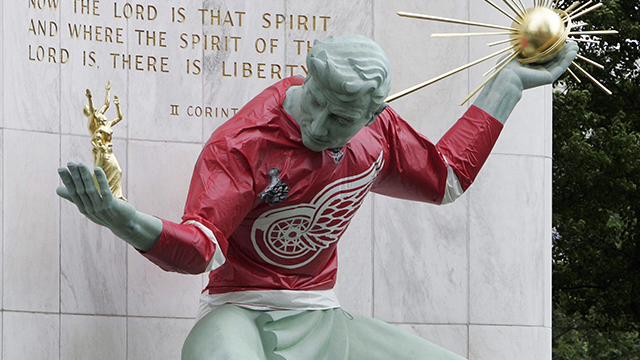Five days before it filed for bankruptcy protection, my wife and I packed up a car and drove to Detroit, to wander the city’s ruins, take in a ball game and celebrate her 30th birthday.
It was early July, midway between the end of the Red Wings latest playoff run and opening day for the Lions. Miguel Cabrera was making an attempt at his second triple crown and the Tigers were already well on their way to securing the AL-Central pennant. But none of this mattered. Not to my wife, anyway. She wouldn’t have known a Tiger from a Lion if they’d lined up at the border to greet her. No, all she knew was that she was rapidly aging behind the wheel as we disappeared into the underwater tunnel that connects America’s most destitute city to one of Canada’s often labeled armpits.
My wife had surprised me a month earlier when I asked her what she’d like to do for her birthday. We were halfway around the world at the time, and had just explored the ruins at Pergamon, a biblical city in modern-day Turkey. Once a thriving metropolis, Pergamon was abandoned by humans about 700 years ago.
Surrounded by the relics of one lost city, she was eager to explore another. “I think I’d like to spend my birthday in Detroit,” she said.
To her Detroit was a fascinating place: a city struggling to rebuild itself in the face of economic collapse. She wanted to spend her birthday photographing 20th century ruins and seeing how a growing group of artists and agriculturalists had managed to repurpose lands and buildings, abandoned by the industrialists who’d once built the city, into something special. But it wasn’t until we got there that we truly understood the ongoing struggle against dereliction was a dichotomous counterweight to the flourishing sports scene which has, for decades, helped to maintain fragments of vibrancy in Detroit’s downtown core. In Detroit, sports act as a unifying force and source of immeasurable pride to the city. This became clear as we exited the slums and entered Comerica Park, passing statues of men like Cobb, Gehringer and Kaline and took our seats behind home plate to share my wife’s birthday with 40,000 sport-crazed Michiganders.
It was in those stands, my wife said, that “the centre of the city’s energy lay.”
Like Pergamon before it, Detroit is a decaying metropolis that has already been partially reclaimed by nature. Yet it remains a determinedly competitive and passionate town; a hub for artists and singers and home to some of the healthiest franchises in North American sports. In that last respect, Detroit seems to provide evidence that there isn’t a direct correlation between a city’s financial prosperity and its athletes’ abilities to perform on the field, court or ice.
Still, Detroit is a mess. Its recent Chapter 9 bankruptcy filing was the largest in US history. Poverty within the city limits has been pegged at above 40 percent. Abandoned buildings can be found anywhere from the downtown core to the suburbs. Entire city blocks sit dark, victims of a prolonged exodus of people and money. Yet the entertainment district, centred around the city’s ballpark, football stadium and hockey arena, seems to be growing. What’s more: the enthusiasm and municipal pride for the city’s sports teams can be spotted on ball caps, t-shirts, jackets and signs hung in restaurant windows and atop the city’s tallest buildings. To the outside world, the Tigers’ logo (the Old English ‘D’) is as recognizable a sports symbol as most. But to Detroiters it serves as a reminder that no matter how wretched life may be, there are still things worth cheering for.
Each of Detroit’s major franchises shares a rich history, deep connection and a seemingly bright future with the city. The Tigers haven’t won the World Series since 1984, but they have become perennial post-season contenders and have one of the highest payrolls in baseball at $148 million a year. The Red Wings are the most dominant hockey franchise of the last 25 years and though the Pistons may not be among the top teams in the NBA right now, they, like the Tigers and Red Wings are among the more iconic in their sport. They also spent over $80 million on free agents this past summer. The Lions are historically the least successful franchise in town, but they have at least moved towards the upper tier of the NFL in recent years and have become increasingly significant to the city’s growing reputation for smashing its face into the ground then getting up and readying for more.
Both the Tigers and the Lions play in new downtown venues while the Pistons play out of a 25-year old suburban palace that still stands as a model for NBA super arenas. Amid the city’s economic hardships, the state of Michigan plans to sink public money ($285 million) toward a $650-million downtown development project. Key to that project: construction of a new home for the Red Wings.
There’s no real modern precedent for what’s going on in Detroit. Municipalities have gone bust before, but none so large as the Motor City. And none with any major sports franchises. Which begs the question: are these teams immune to the city’s financial collapse?
Each franchise enjoys stable ownership and receives fan support from the pockets of wealth that still exist in the city’s suburbs. So long as Detroiters (both urban and suburban) don’t become so destitute or diminished in numbers that they can’t afford to go out to games or buy their team’s merchandise, then the city’s franchises should remain competitive and healthy.
The local unemployment rate (currently hovering around 16 percent) hit 24.9 percent in 2009. That same year the Pistons had the highest attendance record in the NBA. For their part, the Tigers saw their attendance drop by about 8,000 fans per game, while the Lions saw theirs go down by an average of 5,000 per game. That said, attendance at Red Wings games actually went up—by nearly 1,000 fans per night. The numbers have fluctuated in the years since, as has each team’s performance, yet even when a quarter of the city’s labour force was out of work, its sports teams still drew crowds.
The Detroit of today is close in size to the city Ty Cobb called home from 1905 to 1921. The population peaked just shy of 2 million immediately after the Second World War, when Gordie Howe and the Production Line was dominating the NHL while Detroit’s Big Three automakers pillared America’s industrial might. But the human exodus from Detroit had already begun by 1960. By 1984, when the Tigers last won the World Series, the city numbered roughly 1.2 million people. Six years later, with the Japanese automakers challenging the Big Three’s dominance in the domestic car market, Detroit’s economy was depressed and its population had fallen to roughly 1 million. This while the Pistons claimed back-to-back championships.
From the outside Detroit may never have had the same cosmopolitan allure of New York, Chicago, Los Angeles, Toronto or Montreal. But the city and its citizens don’t seem to have ever been content with thinking themselves second class.
The first thing you notice when you emerge on the US side of the Detroit-Windsor Tunnel is the decaying structure that is the Wayne County Building, a 111-year-old five-story assembly of granite and copper, cast and stacked in a mix of Baroque, Beaux-Arts and neo-classical architecture. It is topped with the brass sculptures of two horse-drawn chariots named Victory and Progress, which have weathered nearly every storm to descend on Detroit for more than a century. Together, they remind visitors that Detroiters once dared to dream of their city as something of an Imperial capital. But it’s not just the ornate nature of those chariots, or the majesty of the building upon which they stand that sticks with you as you pass it by. It’s also the “For Sale” sign on its steps.
Detroit is filled with grand old buildings. Many are abandoned, including some of the city’s oldest and tallest bank towers. Not to mention the old rec hall where Joe Louis once perfected his jabs. Others are simply gone. Like Tiger Stadium, which earned its spot on the National Register of Historic Places but was nonetheless demolished in 2008. The former diamond has been converted into somewhat of an urban park where families play catch before heading to Tigers games at their new stadium up the road.
Efforts to make use of or find beauty in the city’s ruins are far reaching. The Heidelberg Project, an outdoor exhibit in one of the city’s more impoverished slums, is perhaps the most tenacious representation of people embracing and fighting their city’s decline. That’s where garbage is nailed to the side of houses as a form of artistic expression, and where it’s recommended you not veer too far from the street if you value your safety. I was reminded of that recommendation last month, when news that Detroit had gone 36 hours “murder free” made headlines across the US.
It says something about the state of a town when it rejoices that none of its citizens have killed any other of its citizens in more than a day. In some ways it speaks to the desperation of the masses who still live here. Yet in other ways, it neglects the reality that though violence plagues the city, Detroit remains rich in culture.
Immediately before making our way to the Tigers game we went to the Detroit Institute of Art, an 85-year-old gallery housed inside an elaborate 20th century rendition of Italian Renaissance architecture. Inside we explored a collection of murals, sculptures and paintings worth millions of dollars. In many ways it’s this side of the city’s culture that is at greatest risk of disappearing, not the city’s sports teams. Portions of that art collection might soon be trekked out of town for public auction. Should that happen, Detroit’s sports teams would have even greater importance to the city’s cultural survival.
As it is, Detroit’s Joe Louis Arena, Comerica Park, Ford Field and The Palace of Auburn Hills already stand as places of cultural refuge.
I can say one thing for certain, inside that ballpark on my wife’s birthday as Detroit’s lawmakers prepared to declare their city bankrupt, nothing seemed to matter but the game on the field. And though it took a few pitches before my wife realized which men were the Tigers and which were the Rangers, it didn’t stop either of us from cheering alongside every other man, woman and child inside that stadium. Detroit, as ruinous as it was, had won us over. As had the fans gathered to scream and chant for their city’s stars.










